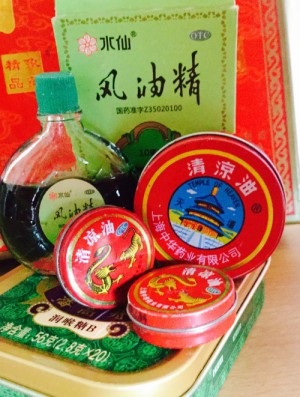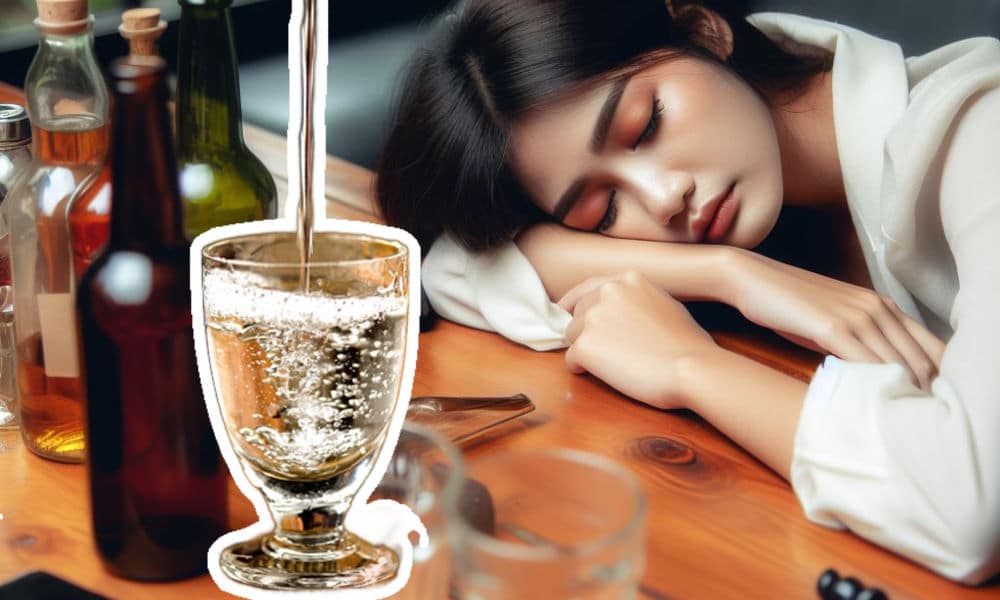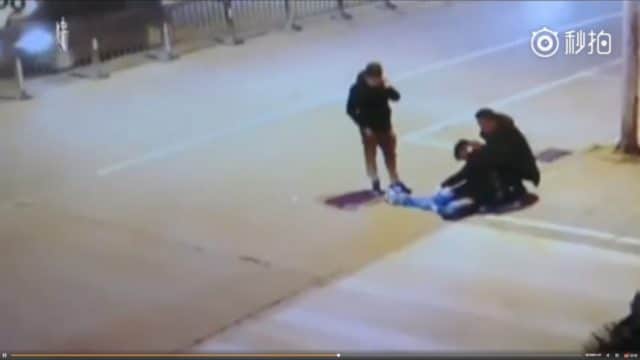China Health & Science
20 Ways to Use Tiger Balm
For most Chinese, Tiger Balm is a classic from grandmother’s cupboard. Reason enough for Sina News to publish a “20 ways to use Tiger Balm” on their Weibo account.
Published
9 years agoon

For many, Tiger Balm is a childhood household item. But for those born after the 1990s, the little red tin is something they only know from their grandmother’s cupboard. Reason enough for Sina News to publish a “20 ways to use Tiger Balm” on their Weibo account, instantly turning it into a trending topic (#清凉油的20个用法#).
Update 2018: Also read our tips on how to use Tigerbalm by Chinese social media users here.
“For the majority of the post-1980 generation, tiger balm is part of their past,” Sina writes: “But for many post 1990-ers and 00-ers, it’s a historical relic. Tiger balm has so many benefits – it is really a good thing from the past. It’s a jack of all trades!” Sina and other media have shared a list of the various ways to use tiger balm.
What is known as ‘tiger balm’ in most western countries is better known as ‘soothing balm’ (清凉油 qingliangyou) or ‘essential balm’ (风油精 fengyoujing) in China; a hot/cool and fragrant balm or oil containing menthol.
 Tiger balm, essential balm and soothing balm (picture by WhatsonWeibo).
Tiger balm, essential balm and soothing balm (picture by WhatsonWeibo).
The original Tiger Balm was developed in Birma in the 1870s, by the China-born herbalist Aw Chu Kin. Different to what the name suggest, Tiger Balm does not contain any ingredients related to the tiger. The balm, containing menthol, mint oil, clove bud oil, cajuput oil and camphor, was named after Aw’s son, whose name literally meant ‘Gentle Tiger’ (Aw Boon Haw, 胡文虎). He was the son who later inherited the recipe of the balm, and turned Tiger Balm into a household name together with his brother.
Apart from the original Tiger Balm (虎標萬金油) there are various brands available in China’s stores, available from drug stores to supermarkets. According to Sina Weibo, this top 20 list contains various ways to use this household classic.
Check out our top 20 list
(Please note that this original list was published by Chinese media. If you’re in doubt about tiger balm usages and/or allergies, consult a doctor before using.)
1. Stung by a mosquito? Tiger balm can help take away the itchiness by applying it directly to the sting.
2. Tiger balm is the perfect insect repellent, as mosquitos and wasps do not like its strong scent. Leave a tin of tiger balm in every corner of the (bed)room during summertime, and leave the lid open. Mosquito’s will not enter a room that reeks of tiger balm.
3. Wooden or bamboo furniture affected by bugs can benefit from treatment with tiger balm. Put some balm on every termite hole of the affected furniture, and they will die out.
4. For those with rheumatic pains, tiger balm can be used as a painkiller by applying it in the lower back area, legs, and directly on sore muscles and bones. Apply as many times as necessary.
5. You’ve been painting the house, and now there are paint stains all over your hands and arms that are not easy to remove by water. Put some tiger balm on a cloth and thoroughly wipe your skin with it. After a couple of minutes, the paint will start letting go, and you can easily pull it off.
6. Weibo suggests that a bad body odor can be cured by the longtime use of tiger balm. Regularly apply tiger balm to the body, the list suggests, and the bad body odors will disappear. You will reek of menthol instead.
7. Got diarrhea (拉肚子)? Rub some tiger balm in and around the navel area, and cover it with the palm of your hand for two or three minutes to let the hotness work on the belly. You can also rub a little bit of balm in between the tailbone and anal area for full effect, the list suggests.
8. The list also suggests to use tiger balm when your baby has an inflamed bottom. Applying tiger balm to the anal area is said to provide some soothing relief. (We are not sure about this one, please always first consult a doctor before applying this balm on babies!)
9. For the early signs of a soar throat, apply tiger balm around the neck area before sleeping. Generously rub it around the neck with the palm of your hand, and your throat will feel better in the morning.
10. Throbbing toothache may feel better after applying some tiger balm to it. Put some balm on a cloth, and rub it into the affected area around the tooth.
11. For mild burns: lightly apply the balm to the afflicted parts. It can help alleviate the pain and avoid blisters. The earlier the balm is applied, the better.
12. Corns and calluses on the feet may disappear after consistent use of tiger balm. Smear the balm directly on to the corn. The list, like this blog, suggests that the balm is warmed with a burning cigarette to improve the balm penetrate into the corn, and to repeat it every day, one to three times a day.
13. Tiger balm is an excellent remedy against headaches. Rub some tiger balm on both temples and reapply if necessary. Be careful not to get the balm in your eyes.
14. When you got a cold and have a stuffed nose, it might help to put some balm right underneath and around the nostrils to let your nose clear up.
15. If you get carsick or seasick easily, moisten the lips with some balm to prevent nausea.
16. Just as tiger balm might help when suffering from diarrhea, it might also help with constipation. Rub some balm around the belly area to ease the stomach.
17. German soccer players have discovered that applying some balm to your chest and calves can help to alleviate the pain associated with fast running.
18. Tiger balm can also be useful when removing the remnants of stickers; rub some in, and you can peel it right off (as also suggested by Vision Times).
19. For those suffering from cold feet in winter, tiger balm might be the solution. Rub the cream into the feet to help stimulate and improve circulation.
20. Bye bye bad smells! Freshen those stinky sneakers and shoes by putting some open packages of tiger balm where you keep your shoes.
Out of Tiger Balm or still not have it in your cupboard. You can order Tiger Balm online from various places:
Buy here:
Tiger Balm White Ointment HR Pain Relief 30g (Big Size)
By Manya Koetse
Follow @WhatsOnWeibo
©2015 Whatsonweibo. All rights reserved. Do not reproduce our content without permission – you can contact us at info@whatsonweibo.com.
Manya Koetse is the founder and editor-in-chief of whatsonweibo.com. She is a writer, public speaker, and researcher (Sinologist, MPhil) on social trends, digital developments, and new media in an ever-changing China, with a focus on Chinese society, pop culture, and gender issues. She shares her love for hotpot on hotpotambassador.com. Contact at manya@whatsonweibo.com, or follow on Twitter.

China Food & Drinks
Chinese Woman with Heartbreak Passes Away after Drinking Bottle of Baijiu
Three friends are held partially responsible for not intervening when the woman consumed 500ml of baijiu.
Published
7 months agoon
December 15, 2023
An incident that happened on the night of May 21, 2023, has become a trending topic on Chinese social media today after a local court examined the case.
A woman named ‘Xiao Qiu’ (alias), a resident of Jiangxi’s Nanchang, apparently attempted to drink her sorrows away after a heartbreaking breakup.
She spent the night at a friend’s house, where she drank about 50cl of baijiu (白酒), a popular Chinese spirit distilled from fermented sorghum that contains between 35% and 60% alcohol. One entire bottle of baijiu, such as Moutai, is usually 50cl.
She was together with three female friends. One of them also consumed baijiu, although not as much, and the two other friends did not drink at all.
As reported by Jiupai News, the intoxicated Xiao Qu ended up sleeping in her car, while one of her sober friends stayed with her. However, at about 5 AM, her friend discovered that Xiao Qiu was no longer breathing. Just about an hour later, she was declared dead at the local Emergency Center. The cause of death was ruled as cardiac and respiratory failure due to alcohol poisoning.
The court found that Xiao Qu’s friends were partly responsible for her death, citing their failure to prevent her excessive drinking and inadequate assistance following her baijiu binge drink session. Each friend was directed to contribute to the compensation for medical expenses and pain and suffering incurred by Qiu’s family.
The friend who also consumed baijiu was assigned a 6% compensation responsibility, while the other two were assigned 3% each.
On Weibo, many commenters do not agree with the court’s decision, asserting that adult individuals should not be held accountable when a friend goes on a drinking spree. Some commenters wrote: “You can tell someone not to drink, but what if they don’t listen?” “Should we record ourselves telling friends not to drink too much from now on?”
This is not the first time for friends to be held liable for an alcohol-related death in China. In 2018, multiple stories went viral involving people who died after excessive drinking at social gatherings.
One case involved a 30-year-old Chinese man who was found dead in his hotel room bathtub in Yangzhou after a formal dinner with friends where he allegedly drank heavily. The man reportedly died of a heart attack. His friends reached a 1 million yuan (±US$157,000) settlement with his family, with the cost shared among the friends who were present during the night.

Surveillance cameras in Jinhua captured how the man was unable to stand or walk after drinking with his friends.
Another case involved a man who died when he was left by his friends at a hotel in Jinhua, Zhejiang province, after heavily drinking at a banquet. Surveillance cameras captured how the man was unable to stand or walk after drinking with his friends. Those friends also paid a compensation together of 610,000 yuan (US$96,000) to the man’s family.
Organisers of an alcohol drinking contest in Henan province were also ordered to pay a compensation of over US$70,000 after one participant died due to excessive alcohol intake in July of 2017.
These cases also triggered online discussions about how Chinese traditional drinking culture often encourages people at the table to drink as much as they can or to exceed their limits; the goal sometimes is to literally “take someone to the ground by drinking.” When someone proposes a toast, everyone at the table is required to finish their glasses, sometimes at a very high pace.
In light of the latest news, some commenters write on Weibo: “No matter what kind of drinking gathering it is, for someone who is already drunk, others should intervene to prevent them from continuing to drink. Even if they invite, provoke, or insist on drinking themselves, they should not be allowed to continue. Otherwise, it not only harms them, you might end up facing legal responsibility yourself.”
Others remind people that overindulging in alcohol when you’re in a state of distress is never a good idea, and that no heartbreak is worth getting drunk over: “There are plenty of other fish in the sea.”
By Manya Koetse
Get the story behind the hashtag. Subscribe to What’s on Weibo here to receive our newsletter and get access to our latest articles:
Spotted a mistake or want to add something? Please let us know in comments below or email us. First-time commenters, please be patient – we will have to manually approve your comment before it appears.
©2023 Whatsonweibo. All rights reserved. Do not reproduce our content without permission – you can contact us at info@whatsonweibo.com.
China Health & Science
‘Sister Blood Points’ Controversy: Shanghai Woman’s Tibet Blood Donations Ignite Privilege Debate
Dozens of local public officials in Tibet donated blood to rescue a Shanghainese woman. Netizens believe it’s a matter of privilege.
Published
8 months agoon
December 9, 2023
The medical rescue of a critically injured Shanghai woman in Tibet has recently triggered major controversy on Chinese social media after netizens suspected that the woman’s treatment may have been facilitated through the abuse of power.
What was supposed to be a romantic honeymoon getaway turned into a nightmare for newlyweds Yu Yanyan (27, 余言言) and her husband Tao Li (29, 陶立).
On October 14, just two weeks after their wedding, the couple from Shanghai was driving on China’s National Highway 219. Their destination was Ngari Prefecture in Tibet’s far west, where the average elevation is 4500 meters.
As they drove by the famous mountain pass Jieshan Daban (界山達阪), situated at an altitude of 5347 meters, they suddenly realized that the altitude was affecting them. Soon, Tao Li, who was driving the car, lost consciousness and crashed the car. Yu Yanyan, on the passenger side, was badly injured in the crash.

The crashed car, image via Beijing News/Xinjinbao (source).
What followed was a complicated, time-sensitive, and costly rescue operation. At the Ngari People’s Hospital (阿里地区人民医院), Yu was diagnosed with a ruptured liver, abdominal bleeding, hemorrhagic shock, and thoracic trauma. She was losing a lot of blood in a short time and required surgery, but there was not enough blood available for a blood transfusion at the time in the sparsely populated region, as reported by Beijing News.
Tibetan Civil Servants to the Rescue
While the hospital made efforts to secure donations, specifically requiring an adequate supply of A+ type blood, Yu’s husband was reportedly advised to reach out to the Shanghai Municipal Health Commission (上海卫健委) to inquire about potential assistance. One of his aunts, or his ‘auntie’, allegedly helped him to contact them.
These efforts appeared to be fruitful. Between October 16-17, just days following the crash, numerous members of the public and dozens of local civil servants in Tibet, including firefighters, policemen, and military personnel, stepped forward to donate blood, contributing to over 7000 mL of A-type Rh-positive blood that ultimately saved Yu’s life.
Allegedly thanks to the Tibet office of the Shanghai Municipal People’s Government, a medical specialist from Shanghai was even sent to assist in the medical treatment of Yu at the Ngari hospital.
As Yu later required more advanced medical care and surgeries, she was advised to go to a bigger hospital. She was then transferred via a specially arranged chartered plane. The total costs of this medical chartered plane flight from Ngari to Sichuan’s Huaxi hospital (四川华西医院), arranged by Yu’s father, allegedly cost 1,2 million yuan (US$169.230).

After receiving surgery at the Huaxi Hospital, Yu was in stable condition and was transferred to Shanghai.
An Abuse of Power?
Yu’s story began drawing notice, eventually garnering nationwide media coverage, after Yu herself posted a video on her social media account (Douyin) in which she recounted her experiences. Yu, who only had a relatively small group of followers, told about her rescue operation and her recovery. But instead of garnering sympathy, it led to many questions from netizens and went viral. The video was later deleted.

Screenshots from the since deleted Douyin video.
Who was the ‘auntie’ who reached out to the Shanghai Municipal Health Commission? How were Tibet public officials made to donate blood for this Shanghai patient? What power dynamics were in play that facilitated the mobilization of people in this manner by the family?
People became upset, as they suspected Yu’s life had only been saved because of an abuse of power, and that ordinary Chinese patients would never have never received a similar treatment.
They started referring to Yu as ‘Sister Blood Points.’ The Chinese term is xuè cáo jiě 血槽姐, with xuè cáo 血槽 (lit. blood groove) often being used in the world of gaming to refer to the health bar, an image in video games that shows the player how much energy or blood or strength they have left before it’s game over.

Various online AI-generated images featuring a portrayal of “Sister Blood Points.”
There were also various digital (AI-generated) images showing Yu surrounded by bags of donated blood, portraying her as a privileged, blood-sucking Shanghai ‘princess’ in Tibet.
Following the online commotion, the Ngari Propaganda Department issued a statement on November 29 promising to look into the issue. Additionally, in the first week of December, various Chinese media outlets also started to investigate the case.
An Ordinary Patient in Extraordinary Circumstances
On December 6, online newspaper The Paper (澎湃新闻) published an article together with Shangguan News (上观新闻) which answered some of the most pressing questions surrounding the case.
The Paper reported that they found no officially organized mobilization of public officials or members of the public to donate blood. Instead, local workers and individuals donated blood after learning about the woman’s situation through various channels, including from the hospital staff. Yu Yanyan’s husband Tao called the successful blood donation campaign a result of “multi-party mobilization” (“这是我们多方动员的结果,确实不是有组织的。”)
The Shanghai Municipal Health Commission also denied that they had contacted health authorities in Tibet to ask civil servants to donate blood. They claimed their members of staff did not personally know the patient nor any members of her or her husband’s family.
Furthermore, the article says that the woman known as ‘auntie’ is a 60-year-old retired woman who previously worked at a crafts factory. Upon learning about Yu’s predicament, she forwarded the information to her daughter-in-law, who works at a bank and also did all she could to spread the news and ask for help. This eventually led to the Tibet office of the Shanghai Municipal People’s Government being updated on the situation.
The Tibet office has refuted any suggestion that personal relationships influenced the procedures that resulted in the dispatch of a Shanghai medical expert to assist at Ngari People’s Hospital. A Shanghai medical team stationed in Tibet received a request for urgent support at the hospital and, following their ethical work guidelines, dispatched an expert to provide assistance.
The Paper further stated that nor Yu, nor her husband or their family were officials. In order to pay for the medical flight, Yu’s parents used family savings and borrowed money from others.
All of the information that was coming out about the entire ordeal seemed to indicate that Yu was just an ordinary patient in extraordinary circumstances.
A Sign of Distrust
While certain commenters believe that the latest information has put an end to weeks of speculation, others continue to harbor suspicions that there might be more to the story – they are not satisfied with the answers provided on December 6.
As some netizens dug up screenshots of online calls for help from Tao, Yu’s husband, some commenters responded: “This only makes it clearer that there’s no special status (特殊身份) here. Real influential officials wouldn’t go so low as to seek help online. A simple phone call would have quickly resolved their issue.”
In the end, the entire ordeal, now labeled “The Civil Servant Blood Donation Incident” (公务员献血事件) on Chinese social media, reveals more about public distrust in the transparency of China’s healthcare system than it does about Yu, her family, or the situation in Tibet.
While frustrations regarding privilege and power abuse within China’s healthcare system have existed for years, this issue has gained significant public attention this year in light of the launch of a top-down anti-corruption campaign targeting the healthcare industry.
This issue is especially important due to China’s longstanding struggle with public mistrust in the medical care sector. Some studies even suggest that China’s healthcare system has suffered from a “trust crisis among the public” since the 1990s (Chen & Cheng 2022, 2).
Multiple factors contribute to the relatively low trust in the Chinese healthcare system, but access and costs both play major roles. The sentence “Getting medical attention is difficult, getting medical attention is expensive” (Kànbìng nán, kànbìng guì 看病难,看病贵) has become a well-known expression among Chinese patients dissatisfied with the challenges they encounter in both accessibility and affordability when seeking medical treatments.
Most medical providers in China have become increasingly commercialized and profit-driven since the 1980s, leading to problems with crime and corruption within the medical system as medical professionals are expected to balance both a focus on patient well-being and financial gain. With doctors contending with low pay and incentive-based labor, bribery has emerged as a well-known problem, often considered somewhat of an “open secret” (Fun & Yao 2017, 30-31).
The prevalence of such issues has fueled public frustration, making individual cases like Yu Yanyan’s a source of intense controversy. In an environment where “getting medical attention is difficult, getting medical attention is expensive,” and where corruption is a notorious problem, many people simply do not think it is possible for one young woman to receive so much medical assistance from doctors and civil servants without the involvement of connections, power abuse, and bribery in the process.
Now that more details about the ‘blood point sister’ story have come to light, most netizens have started to question the truth behind this story and realize that Yu might just be an ordinary citizen, while some bloggers are still demanding more answers. In the end, most agree that it is not really about Miss Yu at all, but about whether or not they could expect similar medical treatment if they would end up in such a terrible situation.
“Is there currently an emergency response system in place that allows ordinary people to seek help in equally urgent crises?” (“当前是否存在一个紧急响应机制,可以让普通人在遇到同样紧急的危机时,能寻求帮助?”) one Sina blogger wonders.
“It is actually not important to know if they had special privileges or not,” one Weibo commenter writes: “I just hope that if patients need donated blood in the future, they will get the same treatment.”
By Manya Koetse, with contributions by Miranda Barnes
Get the story behind the hashtag. Subscribe to What’s on Weibo here to receive our newsletter and get access to our latest articles:
References:
Chen, Lu, and Miaoting Cheng. 2022. “Exploring Chinese Elderly’s Trust in the Healthcare System: Empirical Evidence from a Population-Based Survey in China.” International Journal of Environmental Research and Public Health 19 (24): 16461-.
Fun, Yujing & Zelin Yao. 2017. “A State of Contradiction: Medical Corruption and Strain in Beijing Public Hospitals. In: Børge Bakken (Ed.), Crime and the Chinese Dream, Hong Kong University Press: 20–39.
Spotted a mistake or want to add something? Please let us know in comments below or email us. First-time commenters, please be patient – we will have to manually approve your comment before it appears.
©2023 Whatsonweibo. All rights reserved. Do not reproduce our content without permission – you can contact us at info@whatsonweibo.com.
Subscribe

Weibo Watch: The Future is Here

“Bye Bye Biden”: Biden’s Many Nicknames in Chinese

Enjoying the ‘Sea’ in Beijing’s Ditan Park

A Triumph for “Comrade Trump”: Chinese Social Media Reactions to Trump Rally Shooting

Weibo Watch: Get Up, Stand Up

The Tragic Story of “Fat Cat”: How a Chinese Gamer’s Suicide Went Viral

“Old Bull Eating Young Grass”: 86-Year-Old Chinese Painter Fan Zeng Marries 36-Year-Old Xu Meng

A Brew of Controversy: Lu Xun and LELECHA’s ‘Smoky’ Oolong Tea

Singing Competition or Patriotic Fight? Hunan TV’s ‘Singer 2024’ Stirs Nationalistic Sentiments

Zara Dress Goes Viral in China for Resemblance to Haidilao Apron

Weibo Watch: The Battle for the Bottom Bed

About the “AI Chatbot Based on Xi Jinping” Story

China’s Intensified Social Media Propaganda: “Taiwan Must Return to Motherland”

Weibo Watch: Telling China’s Stories Wrong

Saying Goodbye to “Uncle Wang”: Wang Wenbin Becomes Chinese Ambassador to Cambodia
Get in touch
Would you like to become a contributor, or do you have any tips or suggestions? Get in touch here!
Popular Reads
-

 China Insight3 months ago
China Insight3 months agoThe Tragic Story of “Fat Cat”: How a Chinese Gamer’s Suicide Went Viral
-

 China Music4 months ago
China Music4 months agoThe Chinese Viral TikTok Song Explained (No, It’s Not About Samsung)
-

 China Digital10 months ago
China Digital10 months agoToo Sexy for Weibo? Online Discussions on the Concept of ‘Cābiān’
-

 China Arts & Entertainment12 months ago
China Arts & Entertainment12 months agoBehind 8 Billion Streams: Who is Dao Lang Cursing in the Chinese Hit Song ‘Luocha Kingdom’?








Dian
August 4, 2015 at 5:26 pm
Thank you for sharing this. However, I am pretty sure you mean 拉肚子 instead of 辣肚子 in the 7th way. As a native Mandarin speaker, I don’t think I have ever heard of hot stomach…
Manya Koetse
August 4, 2015 at 5:31 pm
Thanks for your comment, Dian, it has been adjusted!
Brenna
May 2, 2016 at 9:56 pm
Do not put under your nose! I tried it the other night because I saw this, it burned so bad. I had to rub it off my face!
Jill
June 14, 2016 at 6:05 pm
Hello Brenna,
My 70 yr old aunt turned me onto Tiger Balm when I started getting horrible migraines 2 years ago. I now put very very little across my forehead, down the bridge of my nose and a tiny bit (so little) under my nose. It does take a few seconds to get used to the smell but it’s not a horrible smell. And I’m sorry it burned you, but I’ve never had it burn me. The only times I’d heard someone say it burned some was when they used too much in one area. I literally swipe my finger over the top of the balm and spread it where I need it. I never actually take a scoop or any solid part of the balm (that too me is too much). I hope this helps and you try it again in the future. It really has worked for me and I continue to tell others about it.
Gavan
May 20, 2016 at 2:32 pm
Thank you for useful sharing, so I guess someone want to know more about use tiger balm as directed on label http://balmtiger.com you can have a look it.
Shahpaar
July 16, 2016 at 8:00 am
I jokingly refer to it as my best friend. I suffer from headaches and terrible migraines, and Tiger Balm does wonders. I rub it on my temples, forehead, bridge of my nose and around my nostrils. I have been using it almost 29 years, and for me it’s a miracle worker with my pain.
Yasmin
August 6, 2016 at 7:28 pm
Hey, I’m about to buy 1 from Aliexpress. I remember the one in the 80’s was dark color but this 1 today is yellow. Is this the same item as the 80’s?
Gilly
September 8, 2016 at 10:20 pm
I have just bought some of this today from a cheap shop. It cost 98 pence for 2 jars. I used to use zambuk so I am hoping this is as good.
Andrea Wood
October 23, 2016 at 5:38 pm
I have been using Tiger Balm on sore joints and bones. The pain is decreasing, but whatever is wrong seems to be coming out of my skin in the form of redness and blisters. Do you have any idea what would have been wrong for this to be happening? I assumed that I was just having an allergic reaction at first, but then I noticed that I have no skin problem where I accidentally (later on purpose for testing) where there is no pain, but MAJOR reaction where I feel that deep pain. Any ideas what is happening?
Kim
December 28, 2016 at 11:53 pm
Hi, did you get shingles? Just a thought
Babar
October 24, 2016 at 1:50 pm
i know ppl who eat this , they put it in hot coffee or tea, i was shocked every time , i barely can smell it
henock
December 21, 2016 at 8:10 pm
What happen if I used the cream on my face
Anna Estruch
January 19, 2017 at 10:02 pm
Is this product good for nail fungus?
Theresa
February 16, 2017 at 10:16 pm
Anna it is good for nail fungus. Unfortunately the nail will turn color and you have to wait for the nail to grow out but it does work for fungus. Tea tree oil actually works best for nail fungus and no discoloration.
Bert
April 6, 2017 at 1:01 pm
I had someone tell me to put the balm on the tops of my feet to help with sleep. Fall asleep faster and sleep more solid. ??
I’m combing the internet to find anything on this one and so far, not finding anything. I used some of the self stick pads a while back for tennis/golfers elbow. Only thing that helped with the pain. I keep them in supply. Going to put them on the top of my feet tonight. For better sleep, I’ll try anything.
Manuel
April 17, 2017 at 8:58 am
Really good Article Manya, I guess I would add where you can buy some of these, if you are in Australia you can check http://www.tiger-balm.com.au
Missy
July 3, 2017 at 5:45 am
I recently burned my arm with an industrial steamer. Some of the skin has broken open. It’s very sore. My doctor said to keep it moist all the time. A&D ointment or Vaseline. A friend was overseas and burnt his calf on a motorcycle and a premed student in a restaurant gave him tiger balm and he said it healed it in 5 days. But the ingredients sound like it would burn an open wound.
Katby
July 6, 2017 at 5:15 am
My daughter had an insect bite in Thailand a couple of months ago that went bad and was told to put tiger balm on it….3 days and it was better. I use it on midge bites here in UK as I get a bad reaction to them and it is amazing stuff.
Xolani
April 12, 2018 at 2:31 pm
Hi
Does this product Tiger balm helped when you have a problem with early ejaculation?
If is yes please explain to me how and when. someone told me that I should rubbed my penis it will help. please reply on my email address.
Thank you looking forward to your responds
kinds as
Xolani
Tiger Balm
May 18, 2018 at 11:01 am
Hi Manya, it is indeed an inspiring article to show what advantages the Tiger Balm can do for us in our everyday life. Many people are just aware of the regular usage of muscle pain and against flu related issues, but very view people actually know that it is the grandparents secret weapon against so many things at home. The
Tiger Balm Uses are far beyond ones imagination. All the best, Sunisa 🙂
Ryan
June 24, 2018 at 11:37 am
What is the difference between the red and the white??
I’ve only used the red and I know it is AMAZING for Burns, headaches, and Grandpa’s sore legs, joints and muscles from RA. HES HOOKED! lol. Wasn’t sure if the white would be better for his pain relief?
Erica
August 14, 2019 at 6:30 pm
i put this on a milk burn after I read this article. Boy was that a mistake. It burned and swelled up. Please do not put this on any wound.